The Samsung SSD 830 Review
by Anand Lal Shimpi on September 24, 2011 1:02 AM EST- Posted in
- SSDs
- Storage
- Samsung
- pm830
- Samsung SSD 830
AnandTech Storage Bench 2011
Last year we introduced our AnandTech Storage Bench, a suite of benchmarks that took traces of real OS/application usage and played them back in a repeatable manner. I assembled the traces myself out of frustration with the majority of what we have today in terms of SSD benchmarks.
Although the AnandTech Storage Bench tests did a good job of characterizing SSD performance, they weren't stressful enough. All of the tests performed less than 10GB of reads/writes and typically involved only 4GB of writes specifically. That's not even enough exceed the spare area on most SSDs. Most canned SSD benchmarks don't even come close to writing a single gigabyte of data, but that doesn't mean that simply writing 4GB is acceptable.
Originally I kept the benchmarks short enough that they wouldn't be a burden to run (~30 minutes) but long enough that they were representative of what a power user might do with their system.
Not too long ago I tweeted that I had created what I referred to as the Mother of All SSD Benchmarks (MOASB). Rather than only writing 4GB of data to the drive, this benchmark writes 106.32GB. It's the load you'd put on a drive after nearly two weeks of constant usage. And it takes a *long* time to run.
1) The MOASB, officially called AnandTech Storage Bench 2011 - Heavy Workload, mainly focuses on the times when your I/O activity is the highest. There is a lot of downloading and application installing that happens during the course of this test. My thinking was that it's during application installs, file copies, downloading and multitasking with all of this that you can really notice performance differences between drives.
2) I tried to cover as many bases as possible with the software I incorporated into this test. There's a lot of photo editing in Photoshop, HTML editing in Dreamweaver, web browsing, game playing/level loading (Starcraft II & WoW are both a part of the test) as well as general use stuff (application installing, virus scanning). I included a large amount of email downloading, document creation and editing as well. To top it all off I even use Visual Studio 2008 to build Chromium during the test.
The test has 2,168,893 read operations and 1,783,447 write operations. The IO breakdown is as follows:
| AnandTech Storage Bench 2011 - Heavy Workload IO Breakdown | ||||
| IO Size | % of Total | |||
| 4KB | 28% | |||
| 16KB | 10% | |||
| 32KB | 10% | |||
| 64KB | 4% | |||
Only 42% of all operations are sequential, the rest range from pseudo to fully random (with most falling in the pseudo-random category). Average queue depth is 4.625 IOs, with 59% of operations taking place in an IO queue of 1.
Many of you have asked for a better way to really characterize performance. Simply looking at IOPS doesn't really say much. As a result I'm going to be presenting Storage Bench 2011 data in a slightly different way. We'll have performance represented as Average MB/s, with higher numbers being better. At the same time I'll be reporting how long the SSD was busy while running this test. These disk busy graphs will show you exactly how much time was shaved off by using a faster drive vs. a slower one during the course of this test. Finally, I will also break out performance into reads, writes and combined. The reason I do this is to help balance out the fact that this test is unusually write intensive, which can often hide the benefits of a drive with good read performance.
There's also a new light workload for 2011. This is a far more reasonable, typical every day use case benchmark. Lots of web browsing, photo editing (but with a greater focus on photo consumption), video playback as well as some application installs and gaming. This test isn't nearly as write intensive as the MOASB but it's still multiple times more write intensive than what we were running last year.
As always I don't believe that these two benchmarks alone are enough to characterize the performance of a drive, but hopefully along with the rest of our tests they will help provide a better idea.
The testbed for Storage Bench 2011 has changed as well. We're now using a Sandy Bridge platform with full 6Gbps support for these tests.
AnandTech Storage Bench 2011 - Heavy Workload
We'll start out by looking at average data rate throughout our new heavy workload test:

The SSD 830 manages to get within 13% of the SF-2281 based HyperX. While the old 470 couldn't really compete with the current generation of 6Gbps drives, the 830 holds its own. In the performance breakdown we see it's actually in the average read performance that the 830 falls behind. Its lackluster performance here is a bit surprising but given how well the SandForce drives perform it looks like the controller may just be getting bogged down by a bunch of IOs that SF just throws away, which in turn impacts its ability to deliver higher read performance.
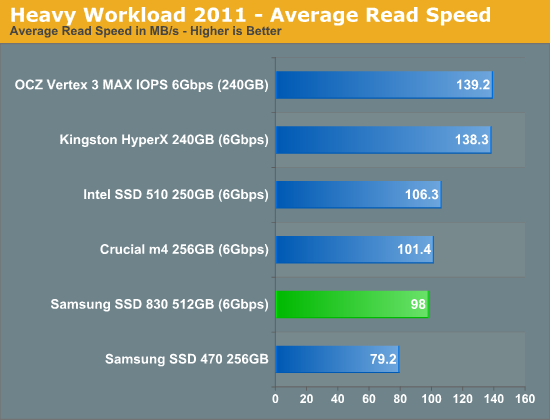
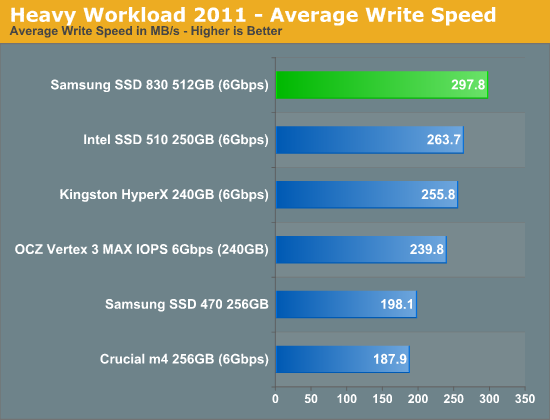
The SSD 830 actually does the best out of all of these drives when it comes to pure write speed. This isn't too surprising given how well the 830 performed in our incompressible sequential write test.
The next three charts just represent the same data, but in a different manner. Instead of looking at average data rate, we're looking at how long the disk was busy for during this entire test. Note that disk busy time excludes any and all idles, this is just how long the SSD was busy doing something:
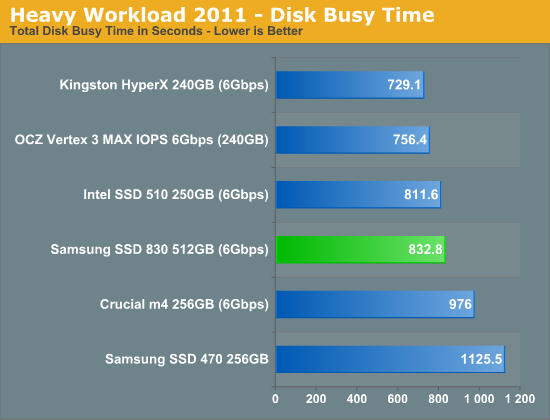
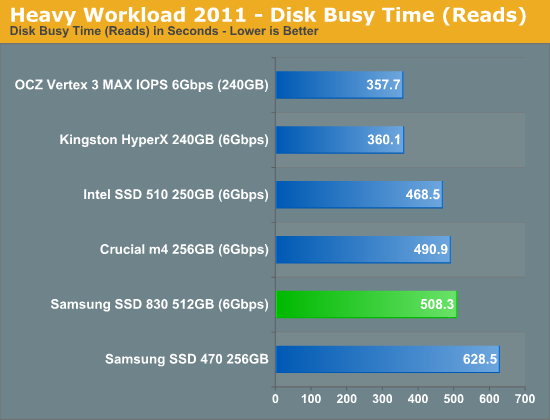
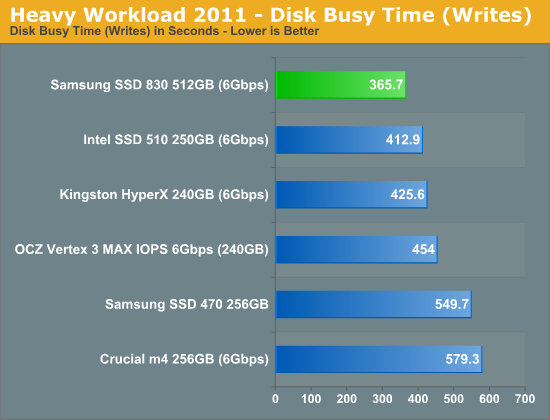










99 Comments
View All Comments
name99 - Saturday, September 24, 2011 - link
5.8W maximum power draw! Ouch.Let's note, for the record, that that means it simply won't work in a USB2 enclosure, and it work work in a USB3 enclosure (4.5W) without a Y-cable.
WTF causes this? If a magnetic hard drive can spin up on USB2 power (2.5W) I remain amazed that SSDs demand so much power when writing.
Jaybus - Tuesday, September 27, 2011 - link
The same thing that causes every transistor based device to consume power, resistivity and capacitance of the materials through which current flows. Resistance produces a loss of energy in the form of heat. Capacitance limits the rise time of the transistors, causing the duty cycle to increase as a function of frequency.Obsoleet - Thursday, January 19, 2012 - link
It's the multichannel read/writes. Takes a ton of energy even vs spinning up a portable drive like my WD Passport USB3.0 1TB.Idontcare - Saturday, September 24, 2011 - link
Loved the video too!I appreciated you candidly sharing your thoughts regarding the two schools of thought on garbage collections (real-time on-the-fly versus delayed-till-idle) :)
Brought to mind the spindle-days of setting up defrag to run during idle times versus real-time defragging that came out right before we stopped needing to defrag altogether :P
ClagMaster - Sunday, September 25, 2011 - link
For most enthusiasts obscessed with performance with money to burn, they seem to care mostly about either bandwidth or cost. They upgrade frequently and seem not to care about longterm value.For the vast majority of mainstream users, who use there computers for creating products and services of lasting (and repeatable) value, ... in short long term value. Mainstream users care the most about reliability, good support, good performance, capacity and then cost.
Thank you for your qualitative comments about the reliability of the SSDs from Samsung (and their rebranders) and its good reputation with Apple and other OEMs for their reliability. I care much more about reliability than I do some of the mind-numbing comparisons that are shown of bandwidth differences spanning about 15% from good to poor. I would rather take a 15% hit in performance from the latest and greatest Vertex III and enjoy 5 years of trouble free operation.
The two most reliable brands of SSD out there is Intel and Samsung according to Anand. Although Intel is more pricy, they offer better firmware and utility support. Like their branded motherboards (which enthusiasts mock for their conventionality but respect for their reliability), I believe Intel does active testing of their SSD's for reliability and longetivity and provides firmware support to make sure that happens. All of its other competitors do not. That is why I now have a 120 GB 510 Series on my PC.
Clearly Samsung and Intel SSD are going to be the choice for business applications.
Fun Guy - Monday, September 26, 2011 - link
"According to Anand...." Is Anand God?Nothing against the guy, but he's just a guy, and he earns money off of this site. No telling how that sways his views (consciously, or unconsciously).
I'll take the aggregate reviews over at New Egg, over any single website operator any day of the week.
JarredWalton - Monday, September 26, 2011 - link
I'd personally take Google and other aggregations of data over Newegg reviews.Jaybus - Tuesday, September 27, 2011 - link
I wouldn't. Disgruntled consumers are far more likely to review than satisfied consumers. Also, NewEgg doesn't post how many items have been sold. It is impossible to determine whether the number of one egg reviews is statistically relevant without knowing how many were purchased.tzhu07 - Friday, December 2, 2011 - link
Yup, this is true. Not to mention the tons of people at Newegg that 1-star products over issues that don't have anything to do with the product itself. For example, not getting rebates.ClagMaster - Wednesday, September 28, 2011 - link
Anand is not God.Anand is an IT professional who operates a hardware review site that I enjoy patronizing for nearly 10 years.
I respect Anand's opinions. And yes, there are some instances where I felt his opinions might have been swayed. But overall, his opinions have stood the tests of time.
I simply appreaciate Anands comments on reliability -- singling out Intel and Samsung drives for a good reputation for reliability and support (Intel).
I think Intel works very hard making sure their motherboards, peripherals and SSD's are reliabile. Intel has a facility in Oregon where they extensively test their motherboards. I am impressed because no other motherboard vendor does this.